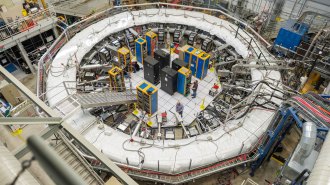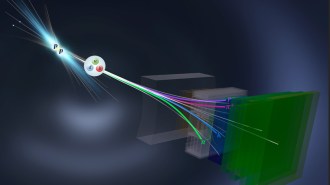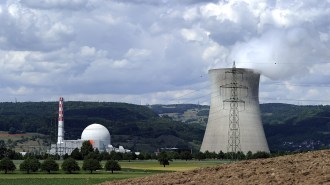How physicists are probing the Higgs boson 10 years after its discovery
The famous particle may point to cracks in the standard model and new physics beyond

Physicists are searching for surprises in the properties and behavior of the Higgs boson. Anything unexpected might point to new physics.
Nicolle R. Fuller/SayoStudio
- More than 2 years ago
Javier Duarte kicked off his scientific career by witnessing the biggest particle physics event in decades. On July 4, 2012, scientists at the laboratory CERN near Geneva announced the discovery of the Higgs boson, the long-sought subatomic particle that reveals the origins of mass. Duarte was an eager graduate student who’d just arrived at CERN.
“I was physically there maybe a week before the announcement,” Duarte says. As buzzing throngs of physicists crowded together to watch the announcement at CERN, Duarte didn’t make it to the main auditorium. That space was for VIPs — and those determined enough to wait in line all night to snag a seat. Instead, he says, he found himself in the basement, in an overflow room of an overflow room.
But the enthusiasm was still palpable. “It was a very exciting time to be getting immersed into that world,” he says. Since then, he and thousands of other physicists from around the world working on CERN experiments have gone all out exploring the particle’s properties.
Scientists predicted the existence of the Higgs boson back in 1964, as a hallmark of the process that gives elementary particles mass. But finding the particle had to wait for CERN’s Large Hadron Collider, or LHC. In 2010, the LHC began smashing protons together at extremely high energies, while two large experiments, ATLAS and CMS, used massive detectors to look through the debris.
Sign up for our newsletter
We summarize the week's scientific breakthroughs every Thursday.
The particle’s discovery filled in the missing keystone of the standard model of particle physics. That theory explains the known elementary particles and their interactions. Those particles and interactions are behind just about everything we know. The particles serve as building blocks of atoms and transmit crucial forces of nature, such as electromagnetism. And the mass of those particles is key to their behavior. If electrons were massless, for example, atoms wouldn’t form. Without the Higgs boson, then, one of scientists’ most successful theories would collapse.
The Higgs boson discovery dominated headlines around the globe. About half a million people tuned in to watch the livestreamed announcement, and footage from the event appeared on more than 5,000 news programs. Even oddball minutiae made it into the press, with a few articles analyzing the physicists’ use of the often-scorned font Comic Sans in their presentation. Little more than a year later, the discovery garnered a Nobel Prize for two of the scientists who developed the theory behind the Higgs boson, François Englert and Peter Higgs — for whom the particle is named.
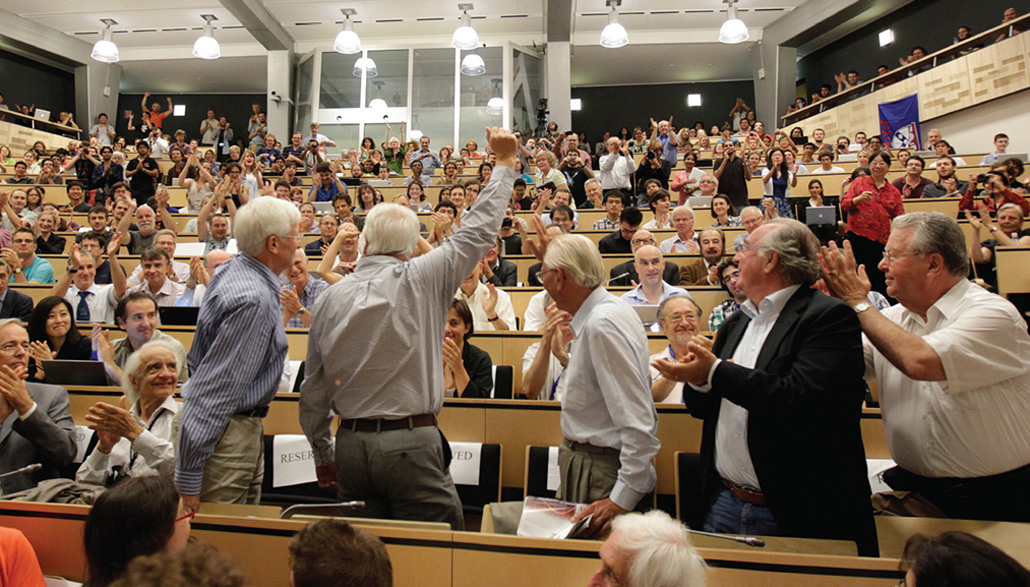
Now, as the discovery turns 10 years old, that initial excitement persists for Duarte and many other particle physicists. As a professor at the University of California, San Diego and member of the CMS experiment, Duarte’s research still revolves around the all-important particle. Progress in understanding the Higgs has been “stunning,” he says. “We’ve come so much farther than we expected to.”
Physicists have been working through a checklist of things they want to know about the Higgs boson. They spent the last decade cataloging its properties, including how it interacts with several other particles. Though measurements have so far been in line with the predictions made by the standard model, if a discrepancy turns up in the future, it may mean there are unknown particles yet to be discovered.
And there’s still more on the agenda. An especially important item is the Higgs boson’s interaction with itself. To help pin down this and other Higgs properties, scientists are looking forward to collecting more data. Scientists turned on an upgraded LHC for a new round of work in April. At the time of the Higgs discovery, collisions at the LHC reached an energy of 8 trillion electron volts. Collisions are expected to roll in at a record 13.6 trillion electron volts starting July 5, and data-taking will continue until 2026. These higher energies offer opportunities to spot heavier particles. And the High-Luminosity LHC, a more powerful iteration of the LHC, is expected to start up in 2029.
“Finding a particle, it sounds like the end of something, but it’s really only the beginning,” says experimental particle physicist María Cepeda of CIEMAT in Madrid, a member of the CMS collaboration.
The standard model
The standard model of particle physics explains the known elementary particles and their interactions. It consists of 17 particles, many of which have antiparticle partners. The fermions, or matter particles, include six types of quarks (blue) and six leptons (pink). The bosons, or force-carrying particles (orange), transmit the fundamental forces. The Higgs boson has special status: It explains the origin of particles’ masses.
Tap the colored sections below for more. Tap the matter/antimatter switch to see matter’s antimatter partners.
Coupling up
Studying the Higgs boson is like geocaching, says theoretical particle physicist Gudrun Heinrich of the Karlsruhe Institute of Technology in Germany. Much like hobbyists use a GPS device to uncover a hidden stash of fun trinkets, physicists are using their wits to uncover the treasure trove of the Higgs boson. In 2012, scientists merely located the cache; the next 10 years were devoted to revealing its contents. And that investigation continues. “The hope is that the contents will contain something like a map that is guiding us towards an even bigger treasure,” Heinrich says.
Detailed study of the Higgs boson could help scientists solve mysteries that the standard model fails to explain. “We know that the theory has limitations,” says theoretical particle physicist Laura Reina of Florida State University in Tallahassee. For instance, the standard model has no explanation for dark matter, a shadowy substance that throws its weight around the cosmos, exerting a gravitational pull necessary to explain a variety of astronomical observations. And the theory can’t explain other quandaries, like why the universe is composed mostly of matter rather than its alter ego, antimatter. Many proposed solutions to the standard model’s shortcomings require new particles that would alter how the Higgs interacts with known particles.
The Higgs boson itself isn’t responsible for mass. Instead, that’s the job of the Higgs field. According to quantum physics, all particles are actually blips in invisible fields, like ripples atop a pond. Higgs bosons are swells in the Higgs field, which pervades the entire cosmos. When elementary particles interact with the Higgs field, they gain mass. The more massive the particle, the more strongly it interacts with the Higgs field, and with the Higgs boson. Massless particles, like photons, don’t directly interact with the Higgs field at all.
One of the best ways to hunt for Higgs-related treasure is to measure those interactions, known as “couplings.” The Higgs couplings describe what particles the Higgs boson decays into, what particles can fuse to produce Higgs bosons and how often those processes occur. Scientists gauge these couplings by sifting through and analyzing the showers of particles produced when Higgs bosons pop up in the debris of proton smashups.
Even if unknown particles are too heavy to show up at the LHC, the Higgs couplings could reveal their existence. “Any of these couplings not being what you expect them to be is a very clear sign of incredibly interesting new physics behind it,” says particle physicist Marumi Kado of Sapienza University of Rome and CERN, who is the deputy spokesperson for the ATLAS collaboration.

Physicists have already checked the couplings to several elementary particles. These include both major classes of particles in physics: bosons (particles that carry forces) and fermions (particles that make up matter, such as electrons). Scientists have measured the Higgs’ interactions with a heavy relative of the electron called a tau lepton (a fermion) and with the W and Z bosons, particles that transmit the weak force, which is responsible for some types of radioactive decay. Researchers also pegged the Higgs’ couplings to the top quark and bottom quark. Those are two of the six types of quarks, which glom together into larger particles such as protons and neutrons. (The Higgs is responsible for the mass of elementary particles, but the mass of composite particles, including protons and neutrons, instead comes mostly from the energy of the particles jangling around within.)
The couplings measured so far involve the standard model’s heavier elementary particles. The top quark, for example, is about as heavy as an entire gold atom. Since the Higgs couples more strongly to heavy particles, those interactions tend to be easier to measure. Next up, scientists want to observe the lighter particles’ couplings. ATLAS and CMS have used their giant detectors to see hints of the Higgs decaying to muons, the middleweight sibling in the electron family, lighter than the tau but heavier than the electron. The teams have also begun checking the coupling to charm quarks, which are less massive than top and bottom quarks.
So far, the Higgs has conformed to the standard model. “The big thing we discovered is it looks pretty much like we expected it to. There have been no big surprises,” says theoretical particle physicist Sally Dawson of Brookhaven National Laboratory in Upton, N.Y.
But there might be discrepancies that just haven’t been detected yet. The standard model predictions agree with measured couplings within error bars of around 10 percent or more. But no one knows if they agree to within 5 percent, or 1 percent. The more precisely scientists can measure these couplings, the better they can test for any funny business.
An interaction checklist
Studying how the Higgs boson interacts with other particles is one way to test whether it fits with predictions of the standard model. Scientists have measured the Higgs’ interactions, or “couplings,” with five standard model particles (dark pink in the graphic), and have early evidence of coupling with a sixth. Heavier particles have been the first targets since they interact more strongly with the Higgs boson (as seen in the graph), so are easier to measure. So far, all measured couplings agree with predictions.
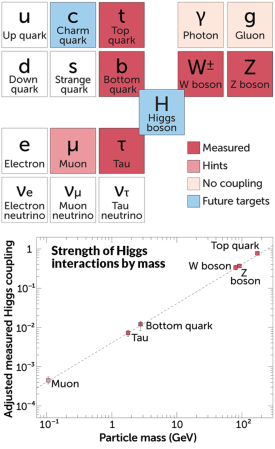
One of a kind
Before the LHC turned on, scientists had a clear favorite for a physics theory that could solve some of the standard model’s woes: supersymmetry, a class of theories in which every known particle has an undiscovered partner particle. Physicists had hoped such particles would turn up at the LHC. But none have been found yet. Though supersymmetry isn’t fully ruled out, the possibilities for the theory are far more limited.
With no consensus candidate among many other theories for what could be beyond the standard model, a lot of focus rests on the Higgs. Physicists hope studies of the Higgs will reveal something that might point in the right direction to untangle some of the standard model’s snarls. “Measuring [the Higgs boson’s] properties is going to tell us much more about what is beyond the standard model … than anything before,” Reina says.
One question that scientists are investigating in LHC smashups is whether the Higgs is truly unique. All the other known elementary particles have a quantum form of angular momentum, known as spin. But the Higgs has a spin of zero, what’s known as a “scalar.” Other types of particles tend to come in families, so it’s not outlandish to imagine that the Higgs boson could have scalar relatives. “It could be there’s a huge scalar sector somewhere hiding and we just saw the first particle of it,” Heinrich says. Supersymmetry predicts multiple Higgs bosons, but there are plenty of other ideas that envision Higgs accomplices.
It’s also possible that the Higgs is not actually elementary. Combinations of particles, such as quarks, are known to make up larger particles with spins of zero. Perhaps the Higgs, like those other scalars, is made up of yet unknown smaller stuff.
While hunting for these answers, physicists will be watching closely for any connection between the Higgs’ behavior and other recent puzzling results. In 2021, the Muon g−2 experiment at Fermilab in Batavia, Ill., reported hints that muons have magnetic properties that don’t agree with predictions of the standard model. And in April, scientists with the CDF experiment — which studied particle collisions at Fermilab until 2011 — found that the W boson’s mass is heavier than the standard model predicts.
The Higgs boson’s relative newness makes it ripe for discoveries that could help sort out these quandaries. “The Higgs boson is the least explored elementary particle, and it could be a door to the other mysteries we still have to uncover or to shed light on,” Heinrich says.
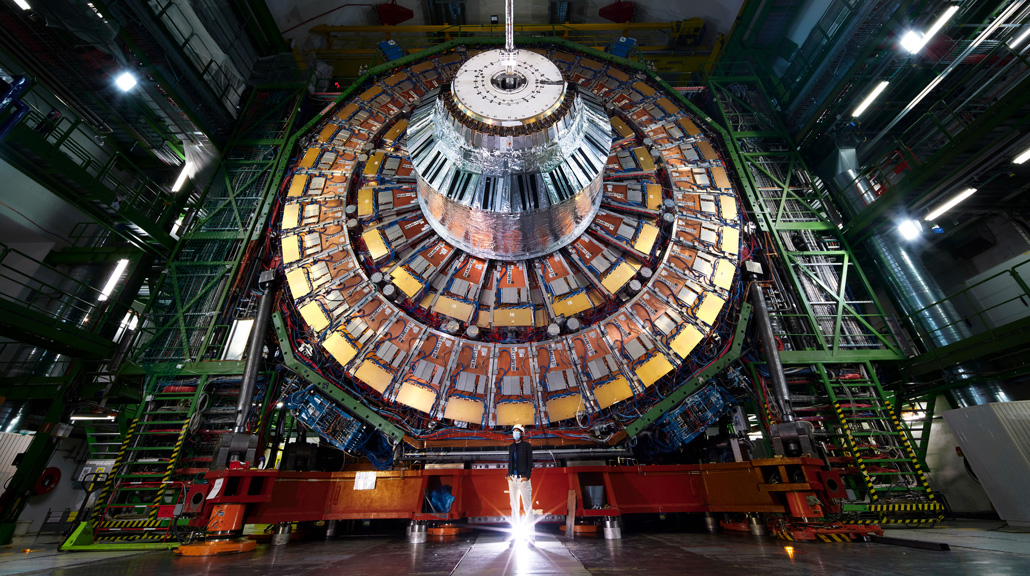
Self-talk
To work out thorny puzzles, physicists sometimes talk to themselves. Fittingly, another puzzle atop scientists’ Higgs to-do list is whether the particle, likewise, talks to itself.
This “self-coupling,” how Higgs bosons interact with one another, has never been measured before. But “it turns out to be really just an incredible barometer of new physics,” says theoretical particle physicist Nathaniel Craig of the University of California, Santa Barbara. For example, measuring the Higgs self-coupling could suss out hidden particles that interact only with the Higgs, oblivious to any of the other standard model particles.
The Higgs self-coupling is closely related to the Higgs potential, an undulating, sombrero-shaped surface that describes the energy of the universe-pervading Higgs field. In the early universe, that potential determined how the fundamental particles gained mass, when the Higgs field first turned on.
How, exactly, that transition from massless to massive happened has some big implications for the cosmos. It could help explain how matter gained the upper hand over antimatter in the early universe. If the Higgs field did play that role in the universe’s beginnings, Craig says, “it’s going to leave some fingerprints on the Higgs potential that we measure today.”
Depending on the full shape of the Higgs potential’s sombrero, at some point in the exceedingly distant future, the Higgs field could shift again, as it did in the early universe. Such a jump would change the masses of fundamental particles, creating a universe in which familiar features, including life, are probably obliterated.
To better understand the Higgs potential, scientists will attempt to measure the self-coupling. They’ll do it by looking for Higgs bosons produced in pairs, a sign of the Higgs interacting with itself. That’s thought to happen at less than a thousandth the rate that individual Higgs bosons are produced in the LHC, making it extremely difficult to measure.
Even with the planned High-Luminosity LHC, which will eventually collect about 10 times as much data as the LHC, scientists predict that the self-coupling will be measured with large error bars of about 50 percent, assuming the standard model is correct. That’s not enough to settle the matter.
If scientists just do what they’re on track to do, “we’re going to fall short,” Duarte says. But new techniques could allow physicists to better identify double-Higgs events. Duarte is studying collisions in which two particularly high-energy Higgs bosons each decay into a bottom quark and a bottom antiquark. Using a specialized machine learning technique, Duarte and colleagues put together one of the most sensitive analyses yet of this type of decay.
By improving this technique, and combining results with those from other researchers looking at different types of decays, “we have a good hope that we’ll be able to observe [the self-coupling] definitively,” Duarte says.
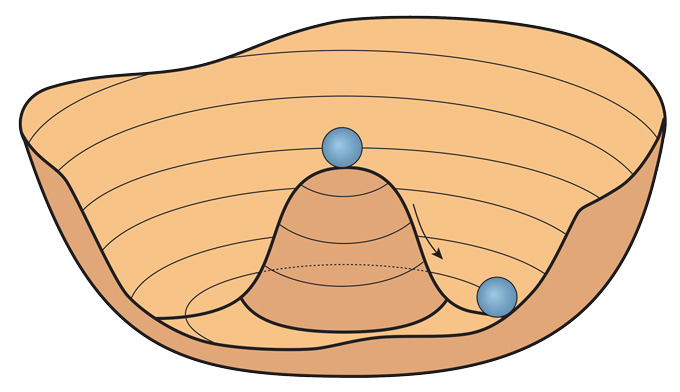
Waiting game
Despite all his passion for the Higgs, Duarte notes that there have been disappointments. After that first rush of the Higgs announcement, “I was hoping for a Higgs-level discovery every year.” That didn’t happen. But he hasn’t lost his optimism. “We expect there to be another twist and turn coming up,” he says. “We’re still hoping it’s around the corner.”
The wait for new physics is no shock to veterans of earlier particle hunts. Meenakshi Narain, a particle physicist at Brown University in Providence, R.I., and a member of the CMS experiment, was an undergraduate student around the time the bottom quark was discovered in the 1970s. After that discovery, Narain joined the search for the top quark. Even though physicists were convinced of the particle’s existence, that hunt still took nearly 20 years, she says. And it took nearly 50 years to uncover the Higgs boson after it was postulated.
The standard model’s flaws make physicists confident that there must be more treasures to unearth. Because of her past experiences with the long-haul process of discovery, Narain says, “I have a lot of faith.”



